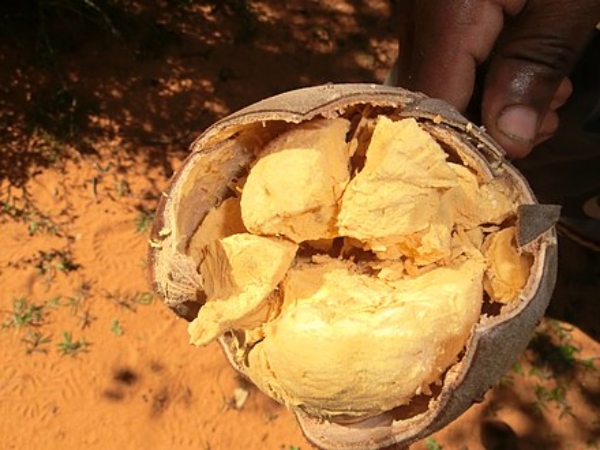Adansonia is a genus of eight species of medium- to large-sized deciduous trees commonly known as baobabs (/ˈbaʊbæb/ or /ˈbeɪoʊbæb/) or adansonias.
They are in the family Malvaceae, subfamily Bombacoideae. They are native to Madagascar, mainland Africa, and Australia.The trees have also been introduced to other regions such as Asia.Genomic and ecological analysis have suggested that the genus is of Malagasy origin.
The generic name honors Michel Adanson, the French naturalist and explorer who described Adansonia digitata.
The baobab is also known as the "upside-down tree", a name that originates from several legends.
It is among the longest-lived vascular plants, and has large flowers that bloom for up to 15 hours.
The flowers open at dusk, opening so quickly that movement can be detected by the naked eye, and fading by the next morning.
The fruits are large, oval to round, berry-like, and contain kidney-shaped seeds in a dry, pulpy matrix.
In the early 21st century, baobab trees in South Africa began dying rapidly for an as-yet-undetermined reason. Disease or pests are unlikely to have killed many of the trees so quickly, and some have speculated that the death was due to drought.
.jpeg)
Description
Adansonia digitata (African baobab) tree in Mikumi National Park with its hanging fruit
Baobab trees are long-lived, small to large deciduous trees that grow 5 to 30 metres (20 to 100 ft) tall[8] with broad trunks and compact crowns. Young trees typically have slender, tapering trunks, often with a swollen base. Mature trees have massive, bottle-shaped or cylindrical trunks that taper from the bottom to the top.[8] The trunk consists of fibrous wood arranged in concentric rings, although the rings are not always formed annually and so cannot be used to determine the age of individual trees.[11] The tree's diameter fluctuates with rainfall, so it is thought that water may be stored in the trunk.[8] Baobabs have two types of shoots - long green vegetative shoots and strong woody ones that reproduce. The branches can be massive and extend horizontally from the trunk or ascend.
Adansonia gregorii is generally the smallest of the baobabs, rarely reaching more than 10 metres (33 ft) in height and often having multiple trunks.Both A. rubrostipa and A. madagascariensis are small to large trees, ranging in height from 5 to 20 metres (16 to 66 ft).[Other baobabs grow 25 to 30 metres (80 to 100 ft) tall, with trunks 2 to 3 metres (7 to 10 ft) in diameter. However, Baobab digitata often has massive single or multiple trunks up to 10 metres (33 ft) in diameter.
Leaves
Leaves are palmately compound in mature trees, but seedlings and regenerating shoots may have simple leaves. The transition to compound leaves comes with age and may be gradual. Leaves have 5–11 leaflets, with the largest ones in the middle and may be stalkless or with short petioles. Leaflets may have toothed or smooth edges, and may be hairless or have simple-to-clumped hairs. Baobabs have stipules at the base of the leaves, but the stipules are soon shed in most species. Baobabs are deciduous, shedding leaves during the dry season.

 Download
Download  Download
Download 





